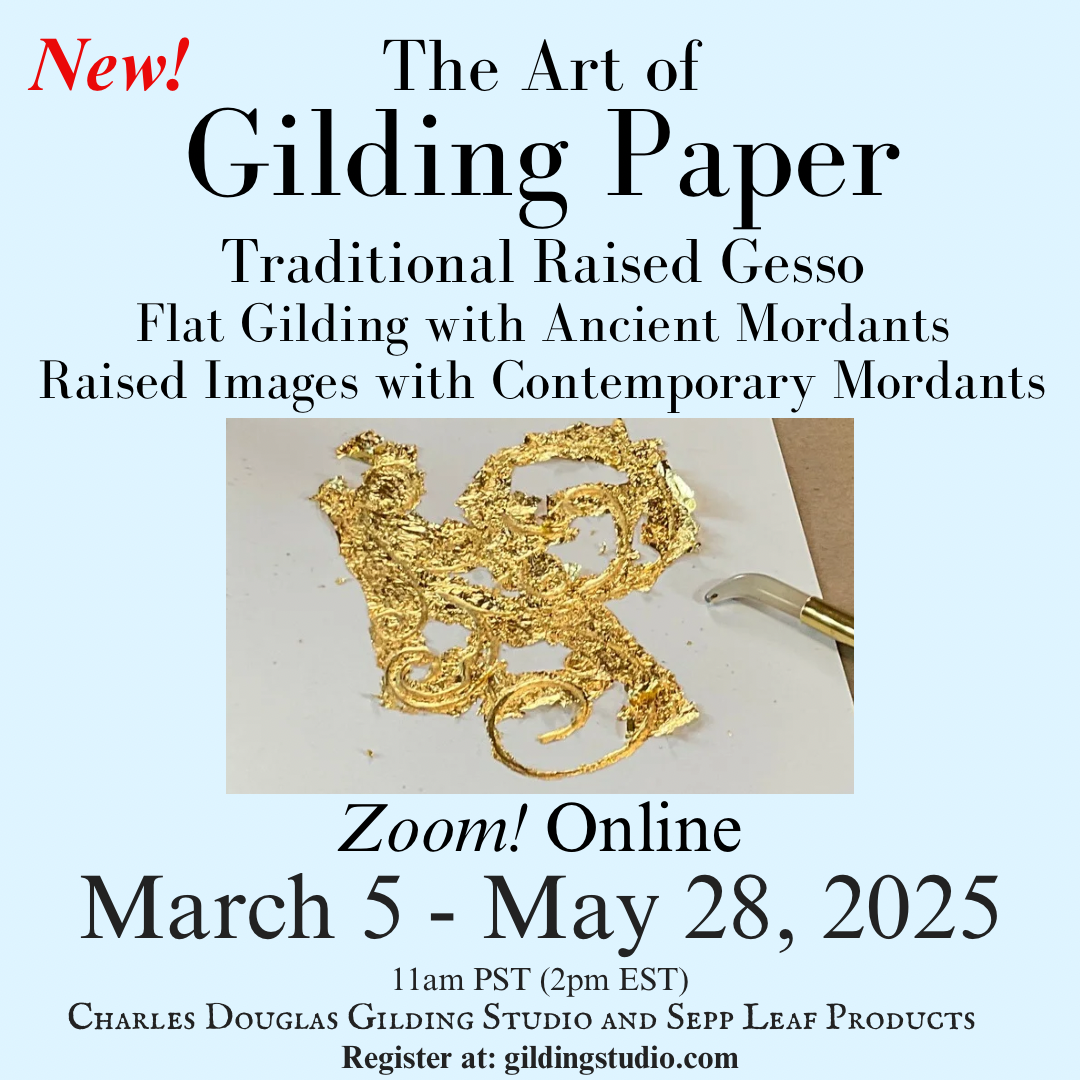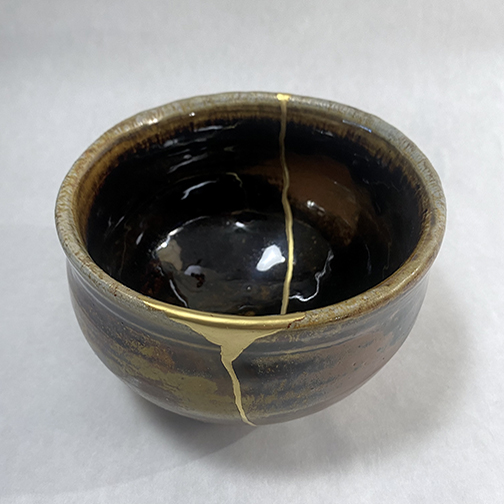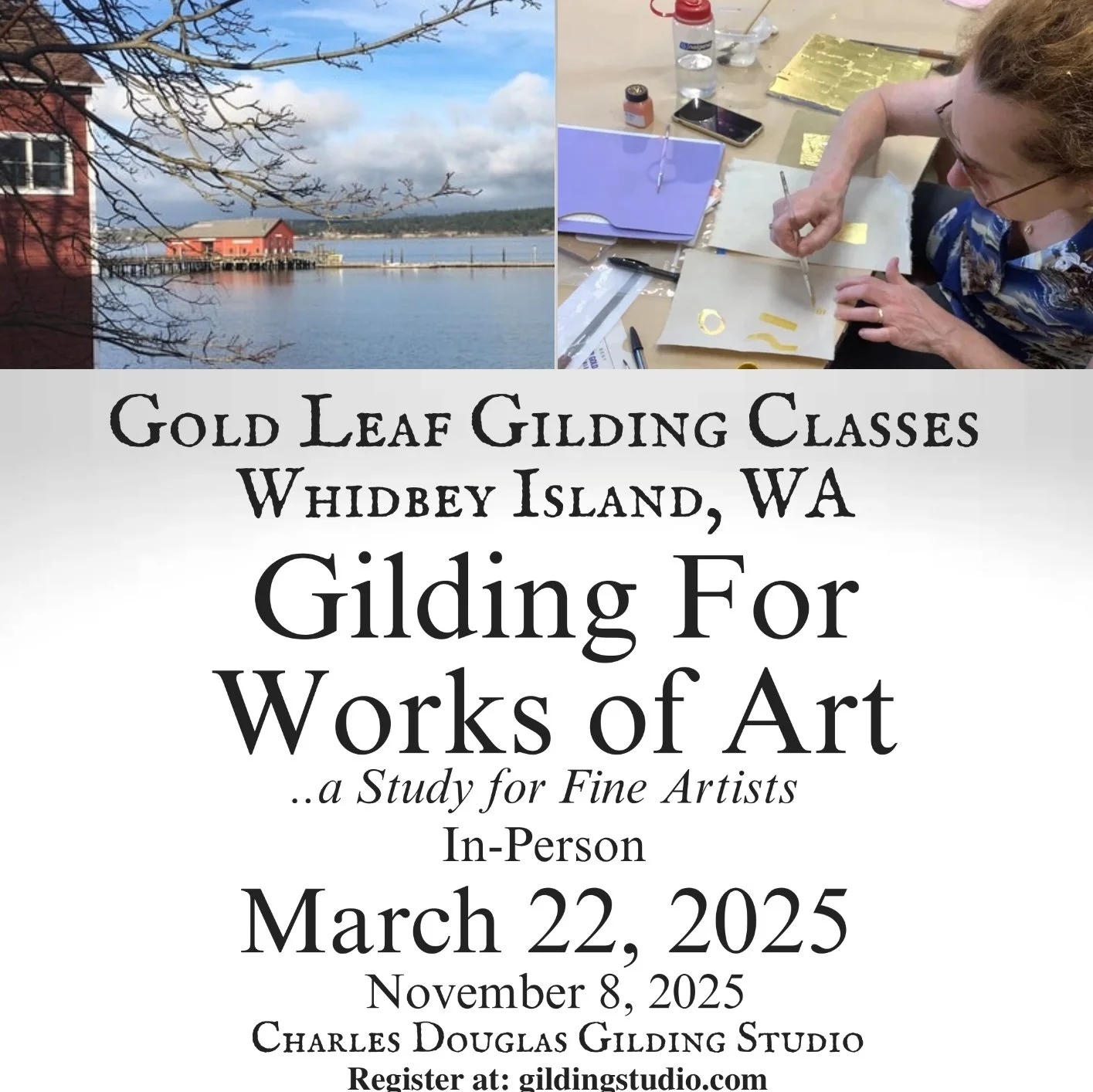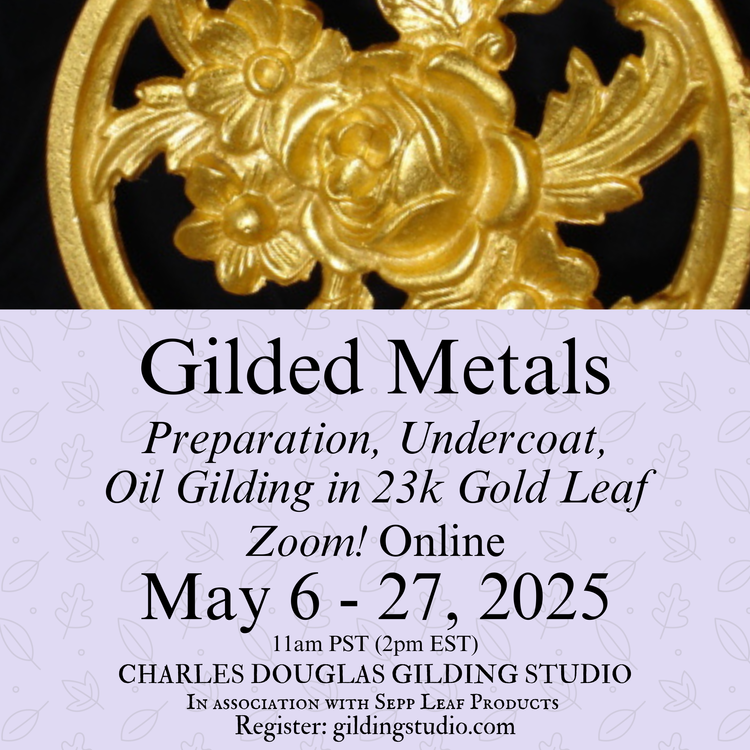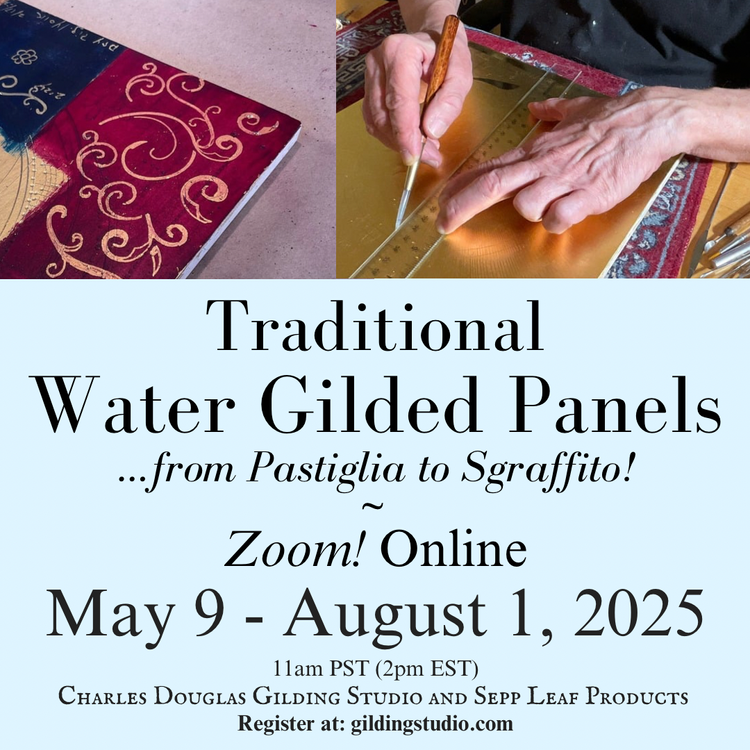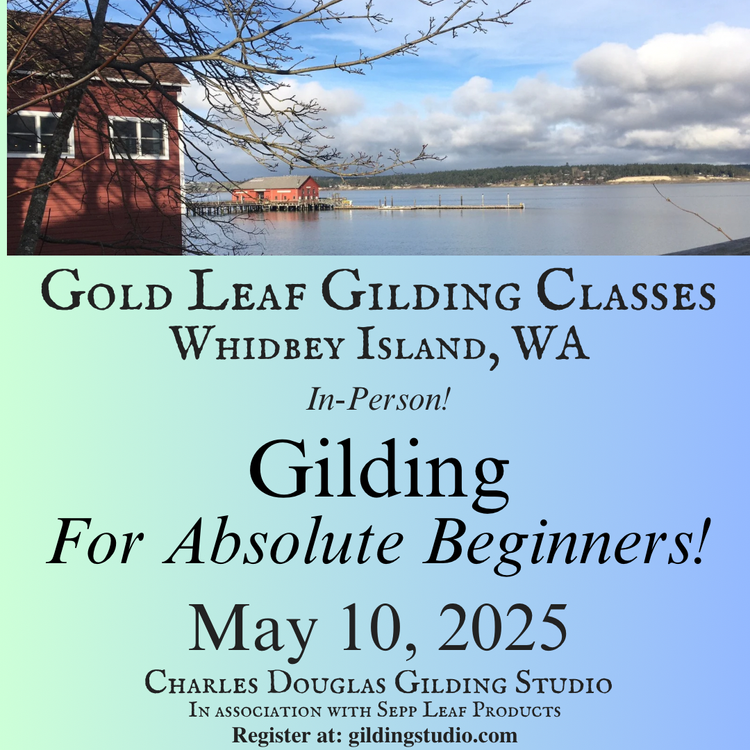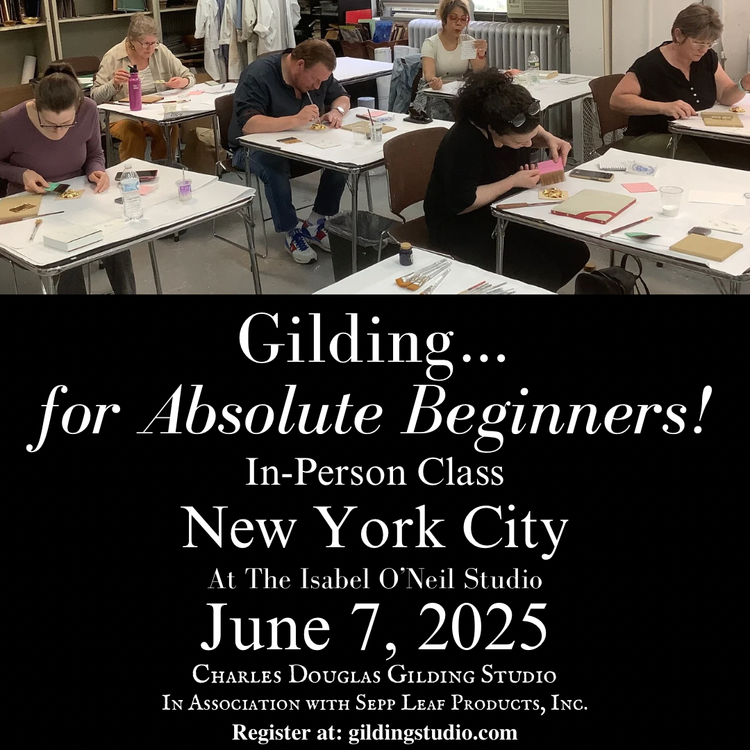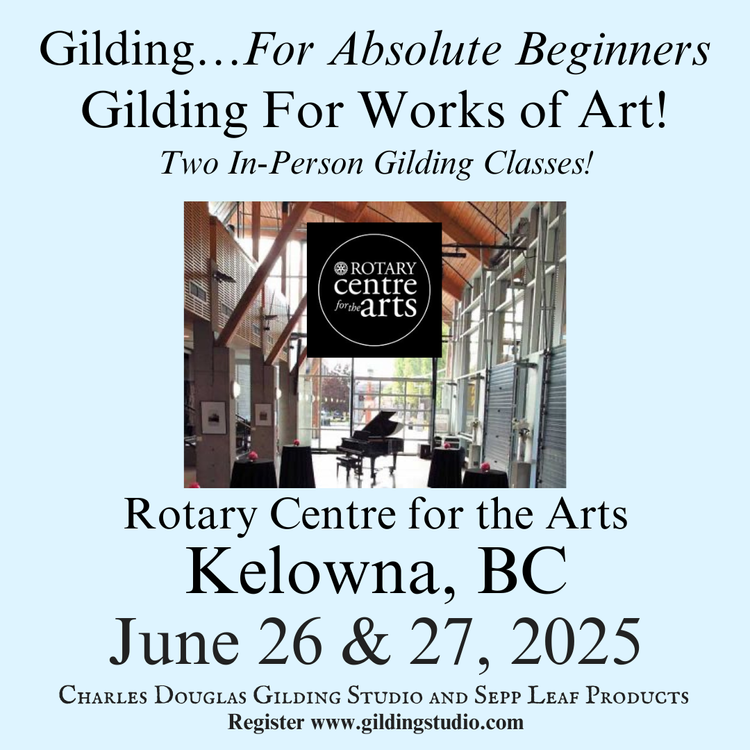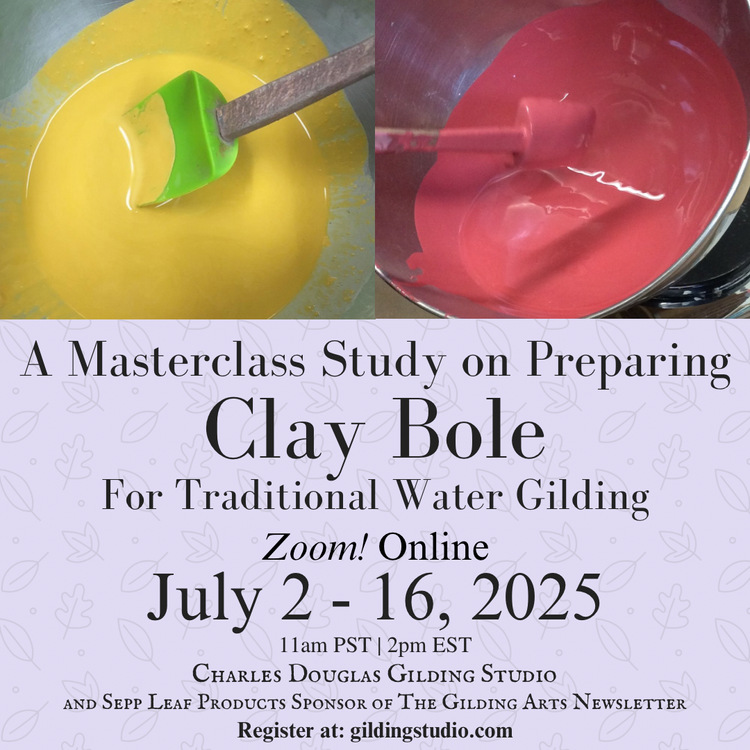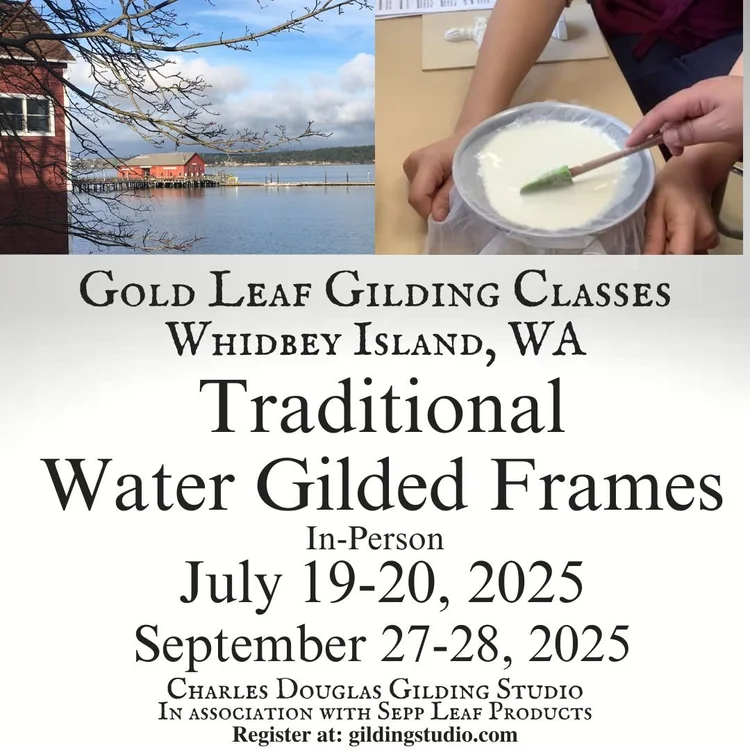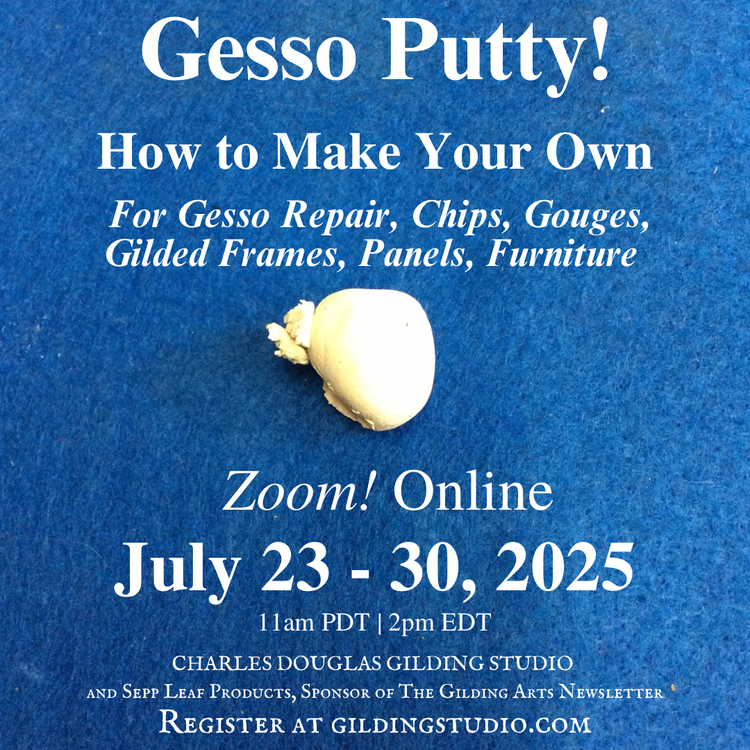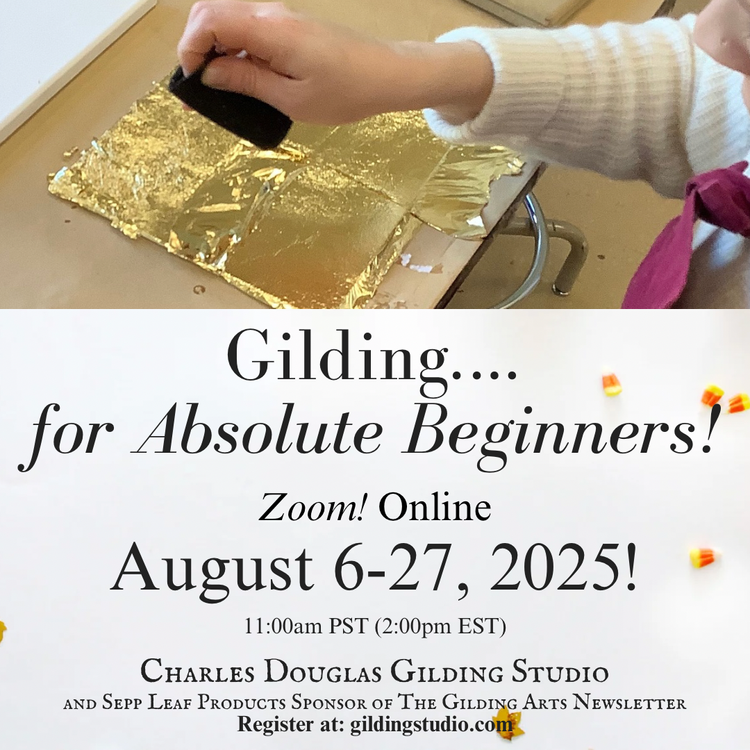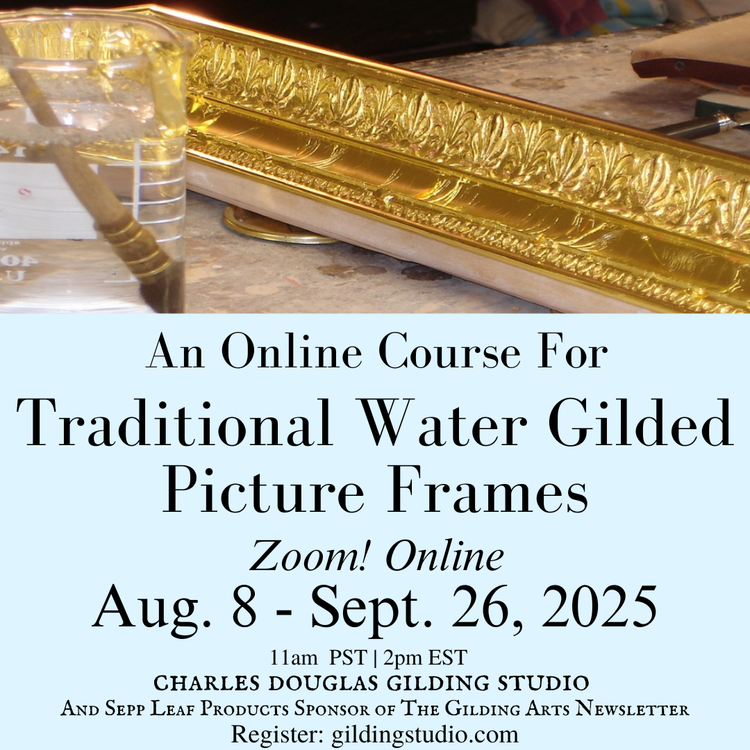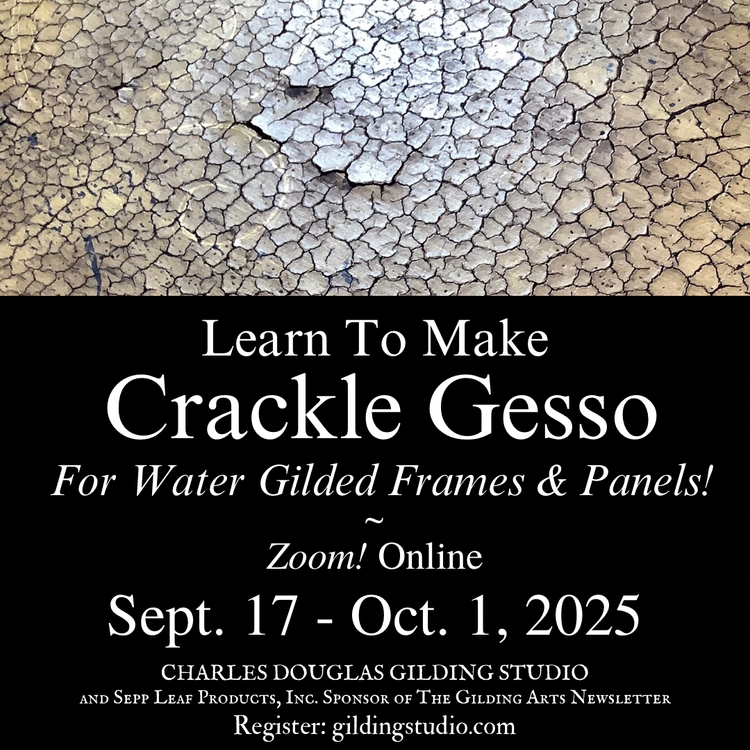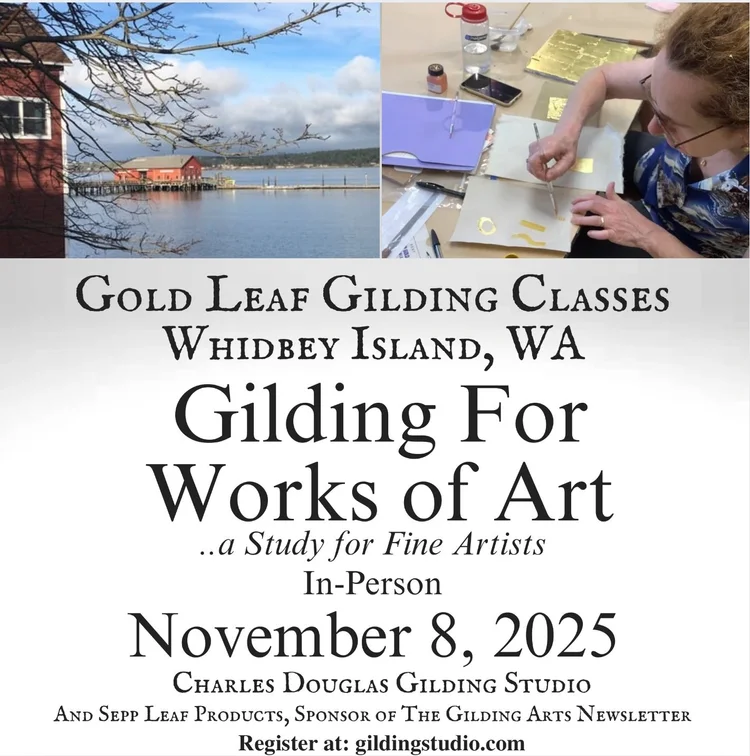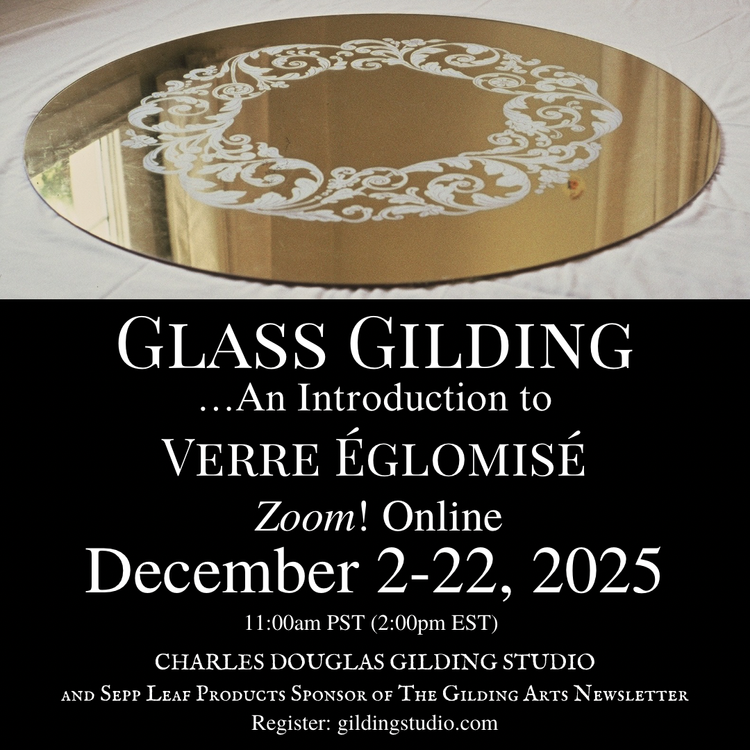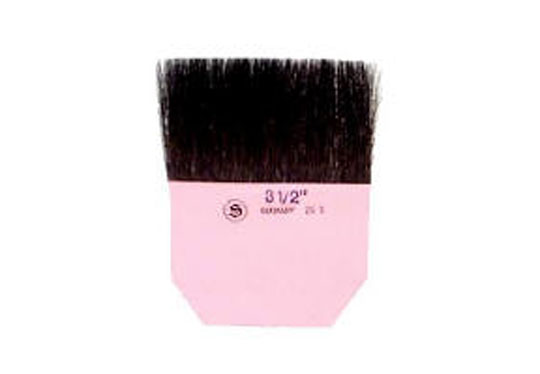Clearance and Close Out items! Reduced pricing on leaf, brushes and more. - Purchase Gift Cards
GildedPlanet Gilding Classes
In-Person and Online via ZOOM - Gold Leaf and Gilding Classes
Join many of the industry's most respected Master Gilders for professional gilding classes! The GildedPlanet.com is proud to partner with exceptional artisans to bring you top-tier, hands-on training in the gilding arts.
These dynamic classes and weekend seminars cover everything from foundational techniques to advanced applications, offering something for everyone—whether you're an interior designer, architect, professional gilder, artisan, or simply fascinated by this ancient craft.
Don't miss this opportunity to immerse yourself in the world of gilding, guided by industry experts. Elevate your skills and create stunning works of art with professional guidance.
Start Your Gilding Journey Today!
Spaces are limited—reserve your spot now and take the first step toward mastering the gilding arts.
Charles Douglas Gilding Studio
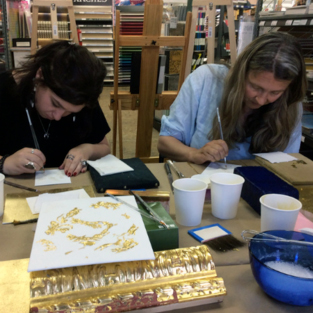
Select from dozens of classes
In-Person and On-Line
Charles Douglas Gilding Studio offers top-tier, hands-on training in the gilding arts. These dynamic classes and weekend seminars cover everything from basic to advanced techniques for a wide range of gilding applications.
Whether you're an interior designer, architect, professional gilder, artisan, or simply fascinated by this ancient craft, the classes offered by Charles Douglas Gilding Studio are a must! Elevate your skills and immerse yourself in the world of gilding with expert guidance.
KINTSUGI

With Catherine Lignier
On-Line
Embracing the beauty of imperfection through the repair of broken ceramics with gold. As one of the few global experts trained by Urushi masters, Catherine offers a rare opportunity to learn this delicate craft, blending traditional techniques with modern accessibility through her interactive online master classes.
Traditional Water Gilding
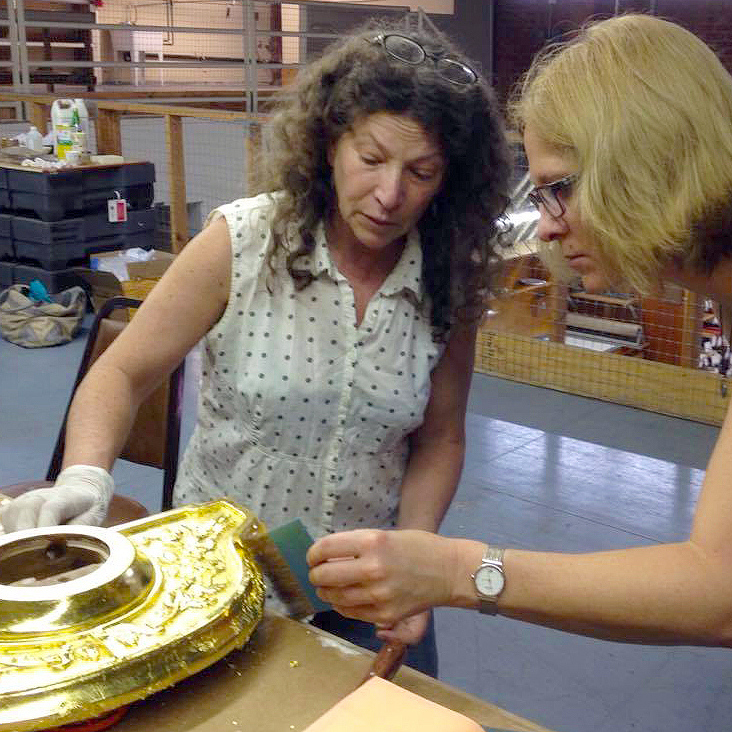
With Jill London
In-Person - San Francisco, Ca.
A four-day class designed for anyone who is interested in water gilding and wants to learn more to improve their skills. The object we will gild from start to finish will be a Florentine picture frame. Students will learn to prepare rabbit skin glue, chalk gesso, bole, gilding liquor and toners. These materials will be applied as a demonstration and each student will work on his/her own frame. Genuine gold leaf will be used and we will learn how to gild out of a book of gold.
January 3 - March 28, 2025
(On-line) Water Gilded Panels~ Pastiglia to Sgraffito!
Kicking off the New winter Series for 2025 with this Special 12 week Workshop designed for the Fine artist working specifically on Panels in Egg Tempera, Oils, or Acrylics. This extended format of the popular Water Gilded Panels class takes the student on a journey through each step of the ancient traditional water gilding method all the way through the historical techniques of Granito (Punchwork and Incision), Pastiglia (Raised Gesso), and Sgraffito (Traditional Egg Tempera applied over the burnished gold leaf with decorative designs etched through to reveal the underlying gold leaf).
Students learn the laying and gluing of Muslin or fine Linen, preparing and applying gesso and clay bole, gilding and burnishing genuine 23k gold leaf as well as adding embellishments through the techniques of granito, pastiglia, and sgraffito. We apply the raised gesso to the panel corners, prepare and apply traditional egg tempera, and incorporate punchwork and incision into the exposed gold leaf that lies below the egg tempera highlighting our sgraffito, an ancient method for catching and reflecting the light.
Each lesson addresses a specific step of the process, keeping it challenging while not overwhelming. Students will need a set of gilding tools such as the pad, knife, and tip, various brushes, a book of 23k gold leaf and a raw wood panel to gild.
March 4 - April 8, 2025
(On-Line) Glass Gilding/Verre Églomisé
A new full 8 week Online Gilding Course introduces students to the art of Verre Églomisé with a focus on achieving a proper balance between brilliancy and bonding between the gold and silver leaf and the glass.
Students will learn to properly clean the glass, choose the appropriate backup paint and explore the following Glass Gilding Techniques:
- Single Gilding, Double Gilding, and Spot Gilding
- The Verre Églomisé technique of Etching Reverse Designs into the Gold to be seen from the Front
- Abrading the Leaf for Antiqued Effects
- Gilding Designs in Positive snd Negative Space
- Gilding the Exterior of Glass as a Decorative Finish
Explore the beautiful artistry of gilded glass and mirrors In both Modern solid gild and abraded ‘antique’ Finishes in 23k Gold snd 6k White Gold Leaf.
March 4 - April 14, 2025
(On-Line) Antique Dutch Black Frame Finish...with Gilded Inner Edge
Join us as we go through each step of the Antique Dutch Black Finish as inspired by 17thc frames from Holland. Before we're finished we'll mordant gild the frame’s Inner Edge in genuine Gold or White Gold Leaf and tone it for aging. A rare opportunity to learn this beautiful Finish for picture frames!
Frame: During each Class Series, Instructor Charles Douglas creates a completely Finished frame with a gilded inner edge for a specific piece of art.
March 5 - May 28, 2025
(On-Line) Gilding on Paper…
Traditional Raised Gesso, Flat Gilding, and Contemporary Relief
There is long historical use of gilding on paper, the earliest known examples dating from 5th to 6th Century Gilded Raised Gesso using elements of traditional water gilding for Manuscript Illumination on parchment.
Today there are ways of creating raised images that are being used by artists to simulate this work without the use of burnishers to make the precious Gold Leaf shine.
Inbetween these Ancient and Contemporary techniques there exists what is known as Flat Gilding, where the paper is gilded flat to the surface. Historical Mordants, or Adhesives, have included Ilinocopia (Garlic Juice), Glair (beaten Egg White), and Gum Ammoniac. Shell Gold, made from ground gold leaf and suspended in a binder of Gum Arabic and stored in Shells was used for painting fine lines.
March 22, 29th, April 5th and 6th 2025
(On-Line) Master Kintsugi Classes
with Catherine Lignier
Transform broken ceramics into exquisite, gold-adorned masterpieces while mastering Kintsugi under the guidance of Catherine Lignier. This exclusive, four-session online course immerses you in the authentic techniques passed down through generations of Japanese Urushi lacquer artisans.
March 22, 2025
(In-Person - Whidbey Island) Gilding for Works of Art
A Study for Fine Artists
This popular one-day Intensive gilding class for Fine Artists is among the Series of Gold Leaf Gilding Classes developed by Gilder and Teacher Charles Douglas. Held in such cities as New York, San Francisco, Christchurch, New Zealand, and Owen Sound, Ontario this particular focus of study is now offered at Charles’ private Gilding Studio on beautiful Whidbey Island, WA where a small group of artists are invited to study incorporating gilding into their own works of art.
Students explore the various techniques of working with gold and silver leaf on canvas, paper, and panels for both background and embellishment.
Learn to lay a genuine 23k gold leaf ground for painting as well as brass and silver colored aluminum leaf. Discover the use of varnish and isolating coats to protect tarnishable metals while successfully painting over the gilding with acrylic and the possibilities with oil and egg tempera mediums.
March 27 - 30, 2025
(In-Person) - Traditional Water Gilding
with Jill London
A four-day class designed for anyone who is interested in water gilding and wants to learn more to improve their skills. The object we will gild from start to finish will be a Florentine picture frame.
Students will learn to prepare rabbit skin glue, chalk gesso, bole, gilding liquor and toners. These materials will be applied as a demonstration and each student will work on his/her own frame. Genuine gold leaf will be used and we will learn how to gild out of a book of gold.
April 5, 2025
(On-Line) Gilding 101
Feeling confused about all the different terms, tools and materials used for gilding? Or wondering where to begin with so many choices?
Gilding 101 is a New Class designed as a suggested Pre-Requisite for new students. You will learn about the different tools used in gilding and what they’re used for. You will learn how to choose the right class and discover the different Gilding Methods and Techniques that are available for you to study.
Whether your interest lies in the historical method of Traditional Water Gilding for Frames and Furniture, Gilding Panels in the tradition of 13th-18thc Florence and Siena, Gilded Raised Gesso on Paper, or other special techniques for Glass, Metal, or Stone, Gilding 101 will answer your questions on How to Begin, What tools you’ll need for the different methods of gilding and where to get them, and how to chart your path!
April 24 - 26, 2025
(In-Person, New Zealand) Gilding Classes: Christchurch, New Zealand
Water Gilding returns to Christchurch, New Zealand! As taught in New York City this popular 3-day class is designed for all those looking to learn the Traditional Method of Water Gilding, from Custom Picture Framers to Fine Artists seeking to incorporate the traditional method of gilding into their Gilded Panel Paintings, suitable for Egg Tempera, Oils, or Acrylics. As we take a journey through each step of this beautiful ancient method of gilding students learn:
- To prepare and apply gesso and clay bole for both Picture Frames and Panels
- Gild by laying genuine 23k gold leaf
- Burnishing
Punchwork, the embossed design elements of Punchwork and Incision as seen on 13th - 18th c Florentine Panels.
Traditional Water Gilding is the same for any object of wood. The subtle differences between gilding Picture Frames, Panels, and other wooden objects will be demonstrated while every student gets to choose a Frame or Panel to gild in class which they get to take home!
May 6 - 27, 2025
(On-Line) Gilded Metals
Gilding Metal is the process of applying a thin layer of Metal to another Metal using either a water or oil-based adhesive. It’s an artform used for Decorative Metal Objects such as Furniture, Exterior Gates, Statuary, and Architectural Elements.
Often a metal such as iron, steel, or aluminum will be gilded with genuine Gold Leaf. Any kt of gold leaf can be used such as 6k or 12k White Gold, 16, 18, 22, 23, or Pure 24k Gold Leaf. Other precious metal leafs sometimes used include Silver, Palladium, and Platinum as well as the base metal leafs Copper, Brass, and Aluminum.
This Special Online Gilding Class Gilded Metals will show you the way that metals are gilded in genuine 23k Gold Leaf as well as Brass Leaf and Aluminum Leaf which uses the Oil Gilding Method.
May 9 - August 1, 2025
(On-Line) Water Gilded Panels ~ from Pastiglia to Sgraffito!
The New 2025 Spring/Summer Series for the Water Gilded Panels class begins in May with this Special 12 week Workshop designed for the Fine artist working specifically on Panels in Egg Tempera, Oils, or Acrylics. This extended format of the popular Water Gilded Panels class takes the student on a journey through each step of the ancient traditional water gilding method all the way through the historical techniques of Granito (Punchwork and Incision), Pastiglia (Raised Gesso), and Sgraffito (Traditional Egg Tempera applied over the burnished gold leaf with decorative designs etched through to reveal the underlying gold leaf).
Students learn the laying and gluing of Muslin or fine Linen, preparing and applying gesso and clay bole, gilding and burnishing genuine 23k gold leaf as well as adding embellishments through the techniques of granito, pastiglia, and sgraffito. We apply the raised gesso to the panel corners, prepare and apply traditional egg tempera, and incorporate punchwork and incision into the exposed gold leaf that lies below the egg tempera highlighting our sgraffito, an ancient method for catching and reflecting the light. The final embellishment will be the added touch of fine lines drawn with 23.5k Shell Gold, another ancient technique for drawing in genuine gold leaf that has been ground and mixed with gum arabic and used as a watercolor while being stored in a shell.
May 10, 2025
(In-Person) Whidbey Island Gilding For Absolute Beginners
We all need to start somewhere and this Introductory gilding class is designed for those just beginning. Students will learn during class to gild an object using brass and aluminum leaf (imitation gold/silver) with the use of acrylic emulsion as the gilding adhesive. It’s what’s known as a mordant and like all acrylics, it’s water-based and cleans with soap and water but dries permanently creating an excellent bond for gold and other metal leafs to a variety of surfaces.
Continuing with the use of acrylic we move to gilding with genuine 23k gold leaf including a brief but intriguing demonstration of other gilding methods such as traditional water gilding and glass gilding/verre églomisé to help prepare students for future study.
Join us for this excellent Introduction to the ancient world of gold leaf gilding! This new addition to the series of Gilding Classes developed by Gilder and Teacher Charles Douglas has fast become a popular one day Introduction to the Gilding World for students anxious to begin and is now offered in Charles’ Gilding Studio on Beautiful Whidbey Island.
June 3, 2025
(In-Person) NYC ~ Gilding for Works of Art
This popular one-day Intensive gilding class for Fine Artists returns to New York City for Spring 2025!
Students explore the various methods of working with gold and silver leaf on canvas and paper for both background and embellishment.
Learn to lay a genuine 23k gold leaf ground for painting as well as brass and silver colored aluminum leaf. Discover the use of MSA Varnish and GAC 200/500 as an isolating coat to protect tarnishable metals while successfully painting over the gilding with your choice of oil or acrylic mediums.
Instructor Charles Douglas will patiently take you through the intricacies of working with delicate gold leaf and how to tame it with the proper use of the gilder's tip, pad, and knife. Explore such ancient mordants as gum ammoniac, and glair, and contemporary oil size and acrylic emulsion.
June 4-6, 2025
(In-Person) NYC ~ Traditional Water Gilding For Picture Frames & Panels
This popular 3-day class is designed for all those looking to learn the Traditional Method of Water Gilding, from Fine Artists to Picture Framers to Furniture Makers and beyond! Students learn to prepare and apply gesso and clay bole, gilding and burnishing genuine 23k gold leaf as we take a journey through each of the steps in this beautiful ancient method of gilding.
Traditional Water Gilding is the same for any object of wood. The subtle differences between gilding Panels, Picture Frames, and other wooden objects will be discussed while every student gets to take home their project gilded in class.
Students may choose either a Frame or Panel for their Class Project (email the Gilding Studio to request your preference after Registering and it will be provided to you on your first day of class).
Whether you’re a Professional Custom Picture Framer, Fine Artist working on Gilded Panel Paintings, Iconographer, interested in Architectural Interiors, or a Student looking to learn the Traditional Water Gilding method you will find this class among the most incredibly useful classes offered in this ancient technique. Immerse yourself in three intensive days of gilding!
June 7, 2025
(In-Person) NYC ~ Gilding for Absolute Beginners
Fascinated by the thought of gilding but simply don’t know where to begin? Then this is the class to take - Gilding…for Absolute Beginners!
We all need to start somewhere and this Introductory gilding class is designed for those just beginning. Students will learn during class to gild an object using brass and aluminum leaf (imitation gold/silver) with the use of acrylic emulsion as the gilding adhesive. It’s what’s known as a mordant and like all acrylics, it’s water-based and cleans with soap and water but dries permanently creating an excellent bond for gold and other metal leafs to a variety of surfaces.
Continuing with the use of acrylic we move to gilding with genuine 23k gold leaf including a brief but intriguing demonstration of other gilding methods such as traditional water gilding and glass gilding/verre églomisé to help prepare students for future study.
June 10 - 18, 2025
(Zoom Online) Gilding… for Absolute Beginners!
Fascinated by the thought of gilding but simply don’t know where to begin? Then this is the class to take - Gilding…for Absolute Beginners!
We all need to start somewhere and this Introductory gilding class is designed for those just beginning.
- Students will learn during their First Session how to seal and apply a yellow and red painted undercoat in preparation for gilding with an acrylic emulsion as the gilding adhesive. This adhesive is known as a mordant and like all acrylics, it’s water-based and cleans-up with soap and water but dries permanently, creating an excellent bond for imitation and genuine gold and other metal leafs to a variety of surfaces.
- We then progress to the gilding in our Second Session, applying brass leaf (imitation gold) to our class project. We’ll also discuss the comparisons between Oil-Based and Acrylic Emulsion Mordants and the applications for both.
- Our Third Session we graduate to gilding a 3-Dimensional Object using genuine 23k Gold Leaf while learning the techniques of using the gilder’s tools: the Pad, Knife, and Tip with guidance in the care of the tools and in handling precious gold and silver leaf.
- Our Fourth and Final Session we review a variety of Gilding Methods and Techniques and provide guidance in choosing your path for your continuing education in the art of gilding. Explore in our last Session such techniques as gilding paper with Ancient and Contemporary mordants, gilding glass, and gain a general overview of the traditional method of Water Gilding!
June 26 & 27, 2025
(In-Person) ~ Gilding Classes ~ Kelowna, British Columbia
Gilding For Absolute Beginners ~ June 26, 2025
Gilding For Works of Art: June 27, 2025
We all need to start somewhere and this Introductory gilding class is designed for those just beginning.
Students will learn:
- To gild a three-dimensional object using brass and aluminum leaf (imitation gold/silver) and Genuine 23k Gold Leaf
- How to handle Genuine Gold Leaf with the traditional Gilder’s Tools while addressing common issues of gold sticking to your knife, static in the room, and knicks in the knife that can tear the gold.
- Apply a Contemporary acrylic emulsion as the gilding adhesive. (It’s what’s known as a mordant and like all acrylics, it’s water-based and cleans with soap and water but dries permanently creating an excellent bond for gold and other metal leafs to a variety of surfaces including artist canvases).
- Learn to prepare and gild with Glair (beaten egg white), an ancient mordant used for paper and glass gilding.
- This is an excellent entry to the beautiful and mysterious world of gold leaf gilding. So bring all of those gilding questions you have had for our hands-on gilding discussions!
July 2 - 16, 2025
(On-Line) ~ A Masterclass Study on Preparing Clay Bole
Getting scratching in your gilding or brush marks in your clay that are affecting the look of your gilding? Still unsure about the right consistency before the glue is added? Then read on!
Clay Bole, the silky smooth clay comprised of aluminum silicate and iron oxide and applied to the surface of the gilder’s gesso plays an integral role in Traditional Water Gilding. It provides a cushion on the underlying hard gesso and offers a sympathetic color under the extraordinarily thin gold leaf, affecting the overall tone of the gilding, from warm to cool.
The proper preparation of the clay is very important in how the final gilding appears. Too thick and unsightly brush marks will appear under the gold; over-polishing the Clay Bole surface can result in poor adhesion between the bole and the gold.
July 8 - 29, 2025
(On-Line) ~ Gilding for Works of Art
Designed for the Fine artist interested in incorporating Gilding into their own Works of Art. Students explore the various methods of working with Brass metal leaf, Aluminum leaf, and Gold and Silver leaf on canvas, paper, and panels for both background and embellishment. Learn to lay a genuine 23k gold leaf ground for painting while discovering the use of MSA varnish and GAC200/500 for protection of tarnishable metals and providing isolating coats for painting in acrylics and a discussion of options in oils.
Instructor Charles Douglas will patiently take you through the intricacies of working with delicate gold leaf and how to tame it with the proper use of the gilder's tip, pad, and knife. Explore such ancient mordants as gum ammoniac, and glair, and contemporary oil size and acrylic emulsion.
July 19 - 20, 2025
(In-Person) Whidbey Island ~ Traditional Water Gilded Frames
The ancient method of Water Gilding has been used to adorn such objects as 13th-18thc Panel Paintings, Early Renaissance to Present-Day Pictures Frames, Furniture, Statuary, Iconography, and Architectural Elements.
The Workshop is held at Charles’ Gilding Studio on beautiful Whidbey Island, WA where a small group of students are invited to study the oldest form of gilding traced back to Mesopotamia more than 3500 years ago.
Students learn to prepare gesso and clay bole grounds, gild in genuine 23k gold leaf, burnish with the agate stone burnisher, and explore an Introductory approach to aging and toning. Students will be provided a picture frame which they will each gild in 23k gold leaf to take home.
July 23, 30, 2025
(On-Line) Gesso Putty. How to Make Your Own
Gesso putty - from making, to filling to shaping! Join us for this special one-part 90 Minute Masterclass on this important component in the restoration and conservation of gold leaf gilded frames, furniture, and other antique gilded wooden objects. Most historical and contemporary forms of gilded wood includes the use of gesso, the foundation for gilding which fills the grain of wood and in the case of traditional water gilding, allows for the burnishing of gold leaf.
Whether through damage or natural degradation, gilded gesso can delaminate, suffer gouging, dents, or other loss through impact or other environmental causes. A putty made from the same materials as traditional gesso is often used in the restoration and conservation of gilding.
August 5 - 26, 2025
(On-Line) ~ The Art of Gilded Raised Gesso
Gilded Raised Gesso, sometimes referred to as Pastiglia is an ancient technique of Traditional Water Gilding often used in Manuscript Illumination. Its raised characteristic was used as Relief ornamentation for manuscripts dating to at least the 12th c as well as frames during the Italian Renaissance as discussed in Cennini’s 15th c Treatise Il Libro Dell’Arte. It remains as an intriguing decorative element today for works of art on Paper, Frames, Panels, and Furniture.
Students will be guided through the process of making and gilding a low Relief for paper while learning to prepare rabbit skin glue size, gum ammoniac, illinocopoia (garlic juice), and gesso. Learn to draw the raised gesso design, prepare clay bole, and gild with breathing through a bamboo straw and burnish 23k gold leaf. Students will also explore Flat Gilding on paper without Relief for contrast.
August 6 - 27, 2025
(On-Line) ~ Gilding…for Absolute Beginners!
We all need to start somewhere and this Introductory gilding class is designed for those just beginning.
Students will learn during their First Session how to seal and apply a yellow and red painted undercoat in preparation for gilding with an acrylic emulsion as the gilding adhesive. This adhesive is known as a mordant and like all acrylics, it’s water-based and cleans-up with soap and water but dries permanently, creating an excellent bond for imitation and genuine gold and other metal leafs to a variety of surfaces.
e then progress to the gilding in our Second Session, applying brass leaf (imitation gold) to our class project. We’ll also discuss the comparisons between Oil-Based and Acrylic Emulsion Mordants and the applications for both.
August 8 - September 26, 2025
(On-Line) ~ Traditional Water Gilded Picture Frames
This popular Workshop takes the student on a journey through each step of the ancient traditional water gilding method, from gesso and clay bole to laying and burnishing genuine 23k gold leaf.
Each lesson addresses a specific step of the process, keeping it challenging while not overwhelming. Creating a modern ‘Rub’ where some of the gold leaf is gently rubbed away to reveal the overlapping leaves of gold and color of the underlying clay bole is also demonstrated.
September 2 - October 28, 2025
(On-Line) ~ Antique Dutch Black Frame Finish...with Gilded Inner Edge
Join us as we go through each step of the Antique Dutch Black Finish as inspired by 17thc frames from Holland. Before we're finished we'll mordant gild the frame’s Inner Edge in genuine Gold or White Gold Leaf and tone it for aging. A rare opportunity to learn this beautiful Finish for picture frames!
Frame: During each Class Series, Instructor Charles Douglas creates a completely Finished frame with a gilded inner edge for a specific piece of art.
September 12 & 13, 2025
(In-Person) ~ Gilding Classes ~ Logan, Utah
Gilding For Absolute Beginners ~ June 26, 2025
Gilding For Works of Art: June 27, 2025
We all need to start somewhere and this Introductory gilding class is designed for those just beginning.
Students will learn:
- To gild a three-dimensional object using brass and aluminum leaf (imitation gold/silver) and Genuine 23k Gold Leaf
- How to handle Genuine Gold Leaf with the traditional Gilder’s Tools while addressing common issues of gold sticking to your knife, static in the room, and knicks in the knife that can tear the gold.
- Apply a Contemporary acrylic emulsion as the gilding adhesive. (It’s what’s known as a mordant and like all acrylics, it’s water-based and cleans with soap and water but dries permanently creating an excellent bond for gold and other metal leafs to a variety of surfaces including artist canvases).
- Learn to prepare and gild with Glair (beaten egg white), an ancient mordant used for paper and glass gilding.
September 17 - October 1, 2025
(On-Line) ~ Learn To Make Crackle Gesso For Water Gilded Panels and Frames
The recipe for Crackle Gesso that students learn produces a crackling pattern similar to 13th-18th c glided Florentine and Sienese Water Gilded Egg Tempera Painted Panels and Renaissance Period Frames . Students learn to prepare and apply this special custom-mixed gesso as well as how to adjust the depth and degree of the crackle through brush technique, heat, and adjusting the ratios of the materials in the gesso mixture.
September 27 - 28, 2025
(In-Person) Whidbey Island ~ Traditional Water Gilded Frames
The ancient method of Water Gilding has been used to adorn such objects as 13th-18thc Panel Paintings, Early Renaissance to Present-Day Pictures Frames, Furniture, Statuary, Iconography, and Architectural Elements.
The Workshop is held at Charles’ Gilding Studio on beautiful Whidbey Island, WA where a small group of students are invited to study the oldest form of gilding traced back to Mesopotamia more than 3500 years ago.
Students learn to prepare gesso and clay bole grounds, gild in genuine 23k gold leaf, burnish with the agate stone burnisher, and explore an Introductory approach to aging and toning. Students will be provided a picture frame which they will each gild in 23k gold leaf to take home.
October 7, 2025
(In-Person) Gilding… for Absolute Beginners! - NYC
Fascinated by the thought of gilding but simply don’t know where to begin? Then this is the class to take - Gilding…for Absolute Beginners!
We all need to start somewhere and this Introductory gilding class is designed for those just beginning. Students will learn during class to gild an object using brass and aluminum leaf (imitation gold/silver) with the use of acrylic emulsion as the gilding adhesive. It’s what’s known as a mordant and like all acrylics, it’s water-based and cleans with soap and water but dries permanently creating an excellent bond for gold and other metal leafs to a variety of surfaces.
Continuing with the use of acrylic we move to gilding with genuine 23k gold leaf including a brief but intriguing demonstration of other gilding methods such as traditional water gilding and glass gilding/verre églomisé to help prepare students for future study.
October 8 - 10, 2025
(In-Person) Traditional Water Gilding For Picture Frame & Panels - NYC
This popular 3-day class is designed for all those looking to learn the Traditional Method of Water Gilding, from Fine Artists to Picture Framers to Furniture Makers and beyond! Students learn to prepare and apply gesso and clay bole, gilding and burnishing genuine 23k gold leaf as we take a journey through each of the steps in this beautiful ancient method of gilding.
Traditional Water Gilding is the same for any object of wood. The subtle differences between gilding Panels, Picture Frames, and other wooden objects will be discussed while every student gets to take home their project gilded in class.
October 15 - Dec 30, 2025
(On-Line) Traditional Water Gilding for Furniture
The exquisite Water Gilded Finish for furniture often shows a contrast of highly burnished Gold Leaf highlights against a softer background of unburnished matt areas such as coves and the backs of Chairs and feet, gilded in a 22-24k gold leaf. Its origins dating to the Early Egyptians over 3,500 years ago, Traditional Water Gilding was later refined during the Renaissance, adorning a variety of Interior Furnishings during the Reigns of Louis XIII thru XVI and the early traditions throughout all of Eastern and Western Europe.
During this 12-Session Gilding Course students learn all of the steps in this beautiful ancient method of Traditional Water Gilding including:
- Preparation and Application of Rabbit Skin Glue, Gesso, and Red over Yellow Clay Bole Grounds
- Application of Intelaggio - thin strips of fabric (or Mulberry paper) on Joints for stability of the gesso
- Gilding in genuine 23k Gold Leaf including Detailed Complex Surfaces
- Burnishing Highlights with an Agate Stone
- Rubbing of leaf of highlights to reveal the underlying color of the Clay Bole to simulate Wear
- Discussion of optional protective Shellac Topcoat
October 17 - Dec 31, 2025
(In-Person) Water Gilded Panels…from Pastiglia to Sgraffito!
Kicking off the New Fall Water Gilding Series for 2025 with this Special 12 week Workshop designed for the Fine artist working specifically on Panels in Egg Tempera, Oils, or Acrylics. This extended format of the popular Water Gilded Panels class takes the student on a journey through each step of the ancient traditional water gilding method all the way through the historical techniques of Granito (Punchwork and Incision), Pastiglia (Raised Gesso), and Sgraffito (Traditional Egg Tempera applied over the burnished gold leaf with decorative designs etched through to reveal the underlying gold leaf).
Students learn the laying and gluing of Muslin or fine Linen, preparing and applying gesso and clay bole, gilding and burnishing genuine 23k gold leaf as well as adding embellishments through the techniques of granito, pastiglia, and sgraffito. We apply the raised gesso to the panel corners, prepare and apply traditional egg tempera, and incorporate punchwork and incision into the exposed gold leaf that lies below the egg tempera highlighting our sgraffito, an ancient method for catching and reflecting the light.
November 4 - 25, 2025
(On-LIne) Toning Gilded Frames
Gilded Frames, Furniture, Panels, and Architectural Elements are often given a Patina whereby various topcoats, Tints, or Washes are applied to simulate age. The gold or silver leaf, both genuine and imitation, may be abraded giving the impression of wear, exposing the underlying colored ground beneath the gilded leaf.
Raw Umber ranging in Values from light passages over 23k water gilded gold leaf to heavier deposits of pigment found on ornate oil gilded brass leafed picture frames. Black in the form of a Casein Wash can offer an intriguing complexity over white gold, silver, palladium, and aluminum leaf
This new, four-part Series takes the student through an Introduction to the Toning process. During class, several objects will be gilded using the Mordant gilded method with both Oil Size and Water Based Leaf Adhesive. An existing example of traditional water gilding will be used in the online demonstrations.
November 4 - 25, 2025
(In-Person) - Whidbey Island - Gilding for Works of Art
This popular one-day Intensive gilding class for Fine Artists is among the Series of Gold Leaf Gilding Classes developed by Gilder and Teacher Charles Douglas. Held in such cities as New York, San Francisco, Christchurch, New Zealand, and Owen Sound, Ontario this particular focus of study is now offered at Charles’ private Gilding Studio on beautiful Whidbey Island, WA where a small group of artists are invited to study incorporating gilding into their own works of art.
Students explore the various techniques of working with gold and silver leaf on canvas, paper, and panels for both background and embellishment.
Learn to lay a genuine 23k gold leaf ground for painting as well as brass and silver colored aluminum leaf. Discover the use of varnish and isolating coats to protect tarnishable metals while successfully painting over the gilding with acrylic and the possibilities with oil and egg tempera mediums.
December 2 - 22, 2025
(On-Line) - Glass Gilding/Verre Églomisé
A new 6 week Online Gilding Course introduces students to the art of Verre Églomisé with a focus on achieving a proper balance between brilliancy and bonding between the gold and silver leaf and the glass.
Students will learn to properly clean the glass, choose the appropriate backup paint and explore the following Glass Gilding Techniques:
- Single Gilding, Double Gilding, and Spot Gilding
- The Verre Églomisé technique of Etching Reverse Designs into the Gold to be seen from the Front
- Abrading the Leaf for Antiqued Effects
- Gilding Designs in Positive snd Negative Space
- Gilding the Exterior of Glass as a Decorative Finish
Explore the beautiful artistry of gilded glass and mirrors In both Modern solid gild and abraded ‘antique’ Finishes in 23k Gold snd 6k White Gold Leaf..




